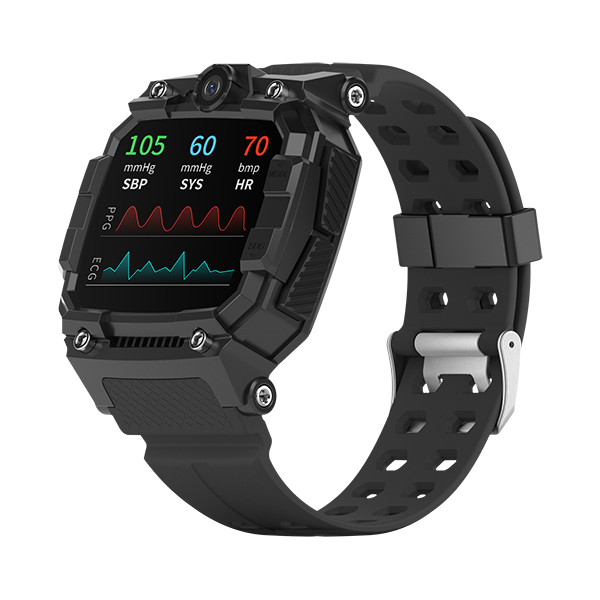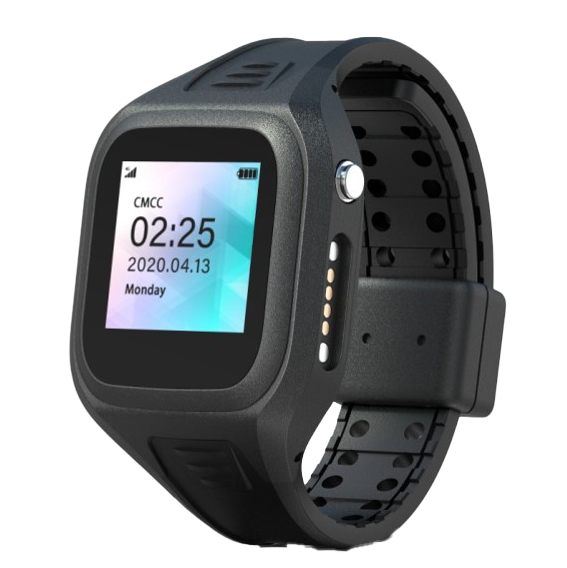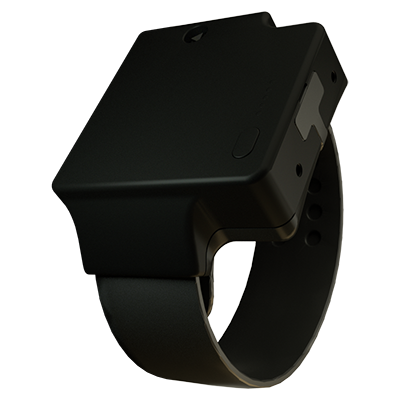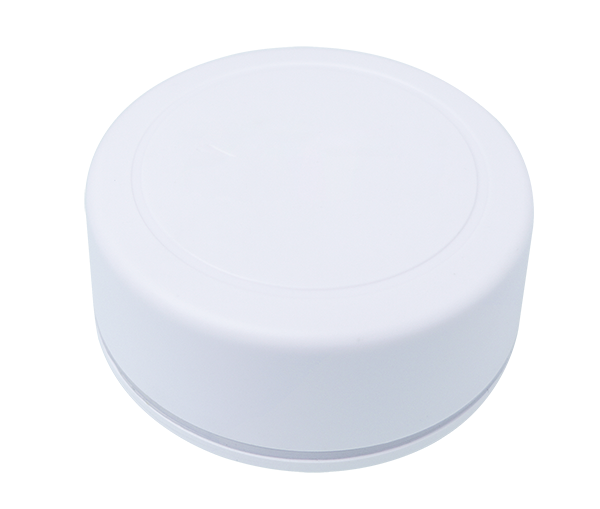Traxbean electronic monitoring system
Traxbean is a SaaS-based security and health monitoring platform that provides a comprehensive monitoring solution for those in care. The platform relies primarily on smart watches, smart GPS locators, Bluetooth beacons, and IoT devices for real-time monitoring of people’s location information, behavior patterns, and health metrics. Our solutions include:
- Community Corrections Electronic Monitoring: Monitoring for inmates outside prisons.
- Personnel monitoring at construction sites, mines, and large venues.
- Surveillance for the elderly and special populations.
Traxbean offers flexible service options that allow customers to use our platform directly to serve their end customers, or opt for a private deployment. Whether you’re using Traxbean’s cloud servers or deploying them privately, we can provide a high degree of customization, including customization of the customer’s brand identity, login screen, national language, and specific features and interface style. In addition, Traxbean not only provides a web login interface, but also develops a mobile application and provides a large-screen LED display solution for customers deployed in private deployments, which is widely used in call centers.
The Traxbean system is designed with advanced distributed design, flexibility and scalability, and supports millions of concurrent connections, serving thousands of enterprises at the same time, making it an ideal choice for large-scale electronic surveillance platforms. In a private deployment scenario, all components and databases can be centrally installed on a single server, reducing usage costs and maintenance complexity.
In addition, Traxbean is able to provide RESTful APIs for third-party platforms or mobile applications, simplifying the system integration process and facilitating seamless integration with other systems.
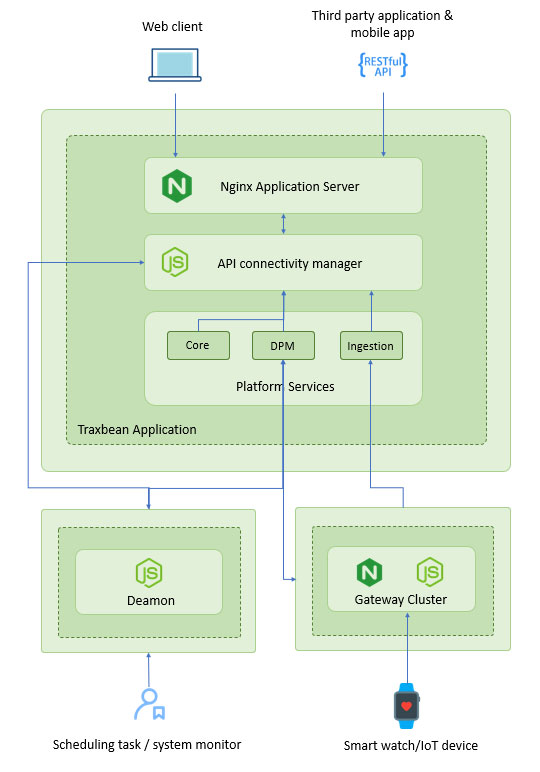
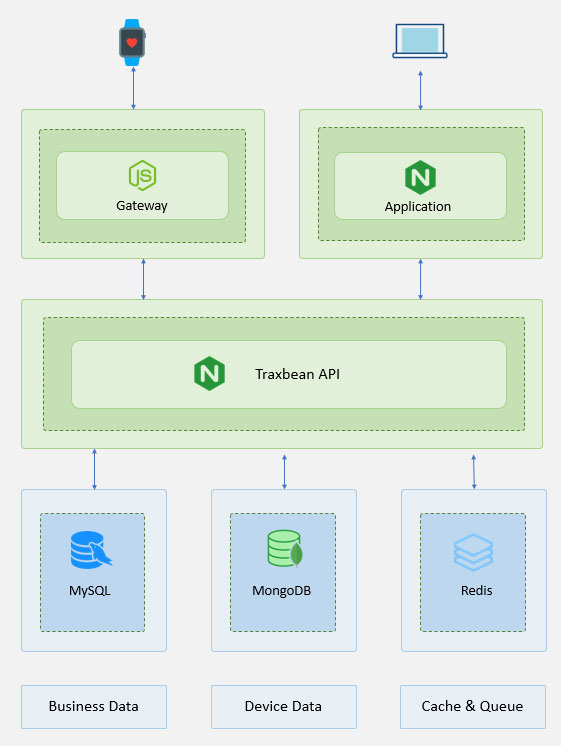
Single Server Deployment
Depending on the load requirements of smart watches and IoT devices, Traxbean electronic monitoring systems can be deployed on a single server with a small number of devices and a small number of users. The system architecture consists of three core modules:
1. Gateway: Responsible for communicating with smartwatches and IoT devices to ensure real-time transmission of data.
2. API: As the core layer of the database and business logic, all service interactions are carried out through this module.
3. Application: Provides a management interface and business processes for users to operate and monitor.
The entire system is based on Node.js development and uses TypeScript as the development language. The business database adopts MySQL and introduces Redis for queue and cache management to optimize performance. In addition, MongoDB is used to store device-related data, including location data, status data, health data, and alarm data. MongoDB is the database with the highest data access frequency and query volume, and the system is designed to meet the needs of efficient queries and flexible and secure long-term data preservation.
Server Requirements
Traxbean electronic monitoring systems are platform-independent software that runs on Linux and Windows servers. For example, if you are hosting 5,000 smartwatches (80% simultaneous online rate), the recommended server configuration is as follows:
Windows Server:
– CPU: 8 cores ≥ 2.5 GHz, Memory: ≥ 32 GB, SSD hard disk ≥ 500 GB, IOPS ≥ 5000, Operating system: Windows Server 2016 or later.
– Software :Node.js, PM2, Nginx, MySQL, MongoDB, and Redis
Linux Server:
– CPU: 8 cores ≥ 2.5 GHz, Memory: ≥ 32 GB, SSD hard disk ≥ 500 GB, IOPS ≥ 5000, OS: Ubuntu 20.04 or above or CentOS 8.0 or above.
– Software :Node.js, PM2, Nginx, MySQL, MongoDB, and Redis
This configuration ensures efficient operation of the system and meets the need for six months of historical data retention.

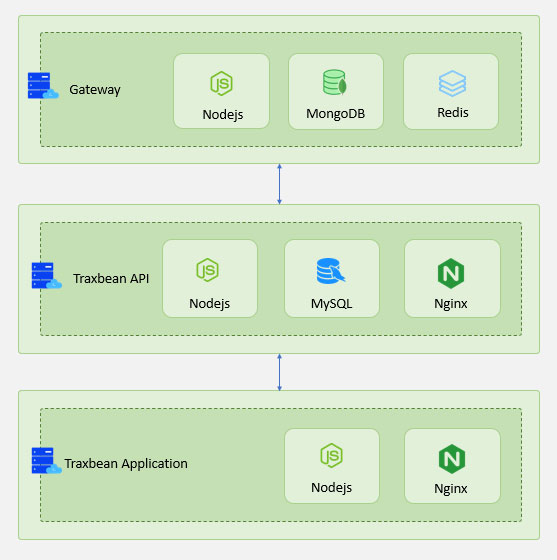
Distributed Deployment Architecture with Multiple Servers
We mainly serve professional clients who need to manage a large number of online devices, such as smartwatches and other IoT devices. To do this, customers typically deploy three or more servers running the Traxbean platform to ensure a higher number of concurrent connections, while taking into account data backup, disaster recovery, and rapid fault recovery.
Although this architecture is too complex to elaborate on in one article, we can provide a rough idea of how to deploy it. We recommend that you deploy your database, gateway, and application on three different servers. API components are installed on the same server as the primary database to improve data access efficiency and simplify maintenance. MongoDB and Redis are installed on the gateway server because the gateway needs to process queue services and a large amount of device upstream data, which can improve processing efficiency.
This three-server architecture configuration is similar to the one described above and can handle 3-5 times more concurrent connections than a single server. For more details, welcome to consult our engineers.
Gateway Load Balancing
When it comes to managing orders of magnitude of simultaneous online devices, a single server or three-server architecture may not be able to handle the huge data throughput efficiently. Continued use of this architecture can result in system crashes, increased data latency, and significant slowdowns in query speed. Therefore, we need to start from the gateway side to solve these problems.
We’re introducing a load balancer to distribute massive amounts of data throughput across multiple servers for processing. The introduction of a load balancer allows us to dynamically scale servers based on the increase in the number of online devices without affecting the normal operation of the system. This ability to scale dynamically increases the flexibility and scalability of the system.
To further speed up data processing, MongoDB, which stores device data, will be deployed on the same server as the gateway. MongoDB will form a replica set with other MongoDB instances in the form of Replica Sets. This configuration not only improves the redundancy and availability of data, but also greatly improves the efficiency of querying data at the application layer, ensuring that the system can respond quickly even under high load. This architectural design combines load balancing and efficient data storage solutions to accommodate the needs of large-scale device management.
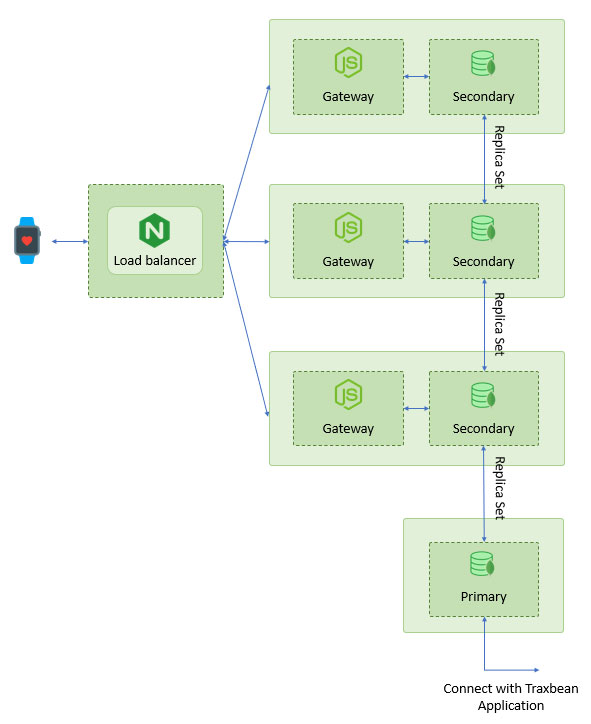
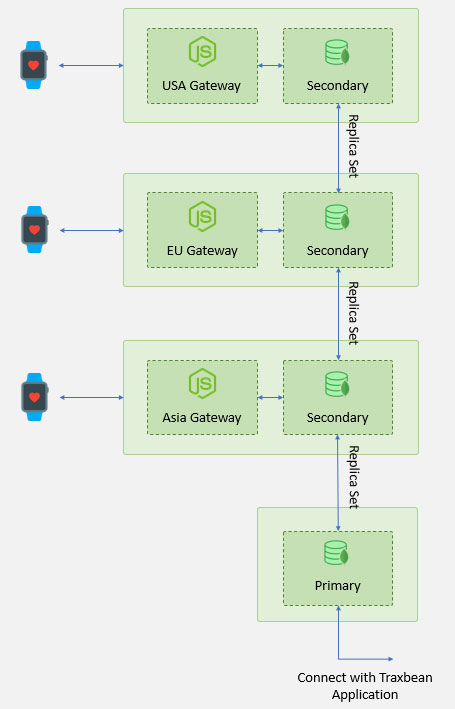
Global Multi-Data Center Distributed Architecture Design
When the Traxbean platform faces more complex issues, such as serving customers around the world, handling massive amounts of online devices, and dealing with customer needs from different countries and regions, a single set of load balancers cannot meet these requirements. To do this, we need to deploy data centers on all continents, ensuring that there are servers in each region for efficient data processing.
Using a local data center to receive data can significantly improve response times and data transfer efficiency. By building a replica set architecture through the backbone network between the various data centers, we can synchronize data in real time. This architecture ensures the timeliness of global data and avoids data loss due to network latency. For example, when a user queries data located in Europe at an Asian branch, the replication set architecture can effectively reduce query latency and improve the overall performance of the system.
In addition, this distributed architecture enhances the fault tolerance and scalability of the system, allowing servers to be dynamically added to handle the growing number of online devices and user requests. The combination of high-bandwidth connections between data centers and the configuration of load balancers enables the entire system to flexibly respond to the needs of different regions, ensuring efficient and stable data processing. The overall architecture design is shown in the figure.
Integration Architecture of Application Layer Load Balancing
In a scenario where a group manages a large number of online devices, users may be distributed in different regions and time zones and frequently query data. Therefore, in addition to ensuring that the gateway for receiving device data has efficient load balancing capabilities, our design also needs to include load balancing at the application layer.
At the application layer, not only do we need a load balancer to intelligently distribute requests to different servers, but we also need to localize data processing as much as possible to reduce latency. For frequently queried data, we will adopt a read/write splitting architecture, where the primary database is responsible for writing operations and the secondary database is focused on read requests. This method not only ensures data consistency, but also improves query efficiency through data redundancy to ensure that the system can still respond quickly when the concurrency is high.
In addition, considering the need to store a large number of picture and video files in the system, we must optimize the file management strategy. It’s not feasible to quickly sync files directly to individual application servers behind a load balancer, so we’re introducing an object storage solution like AWS S3 or similar services to store and manage large files here. Not only does this reduce the burden on application servers, but it also increases file access speed through CDNs (Content Delivery Networks), ensuring that users can quickly download and view media content in any region.
In summary, our design not only focuses on efficient data processing and load balancing, but also comprehensively considers the optimization of file management and storage to build an efficient, flexible, and globally responsive system architecture.
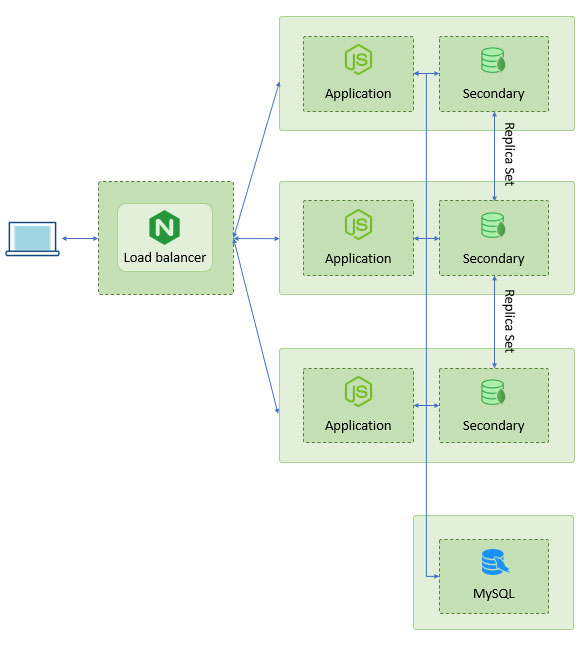
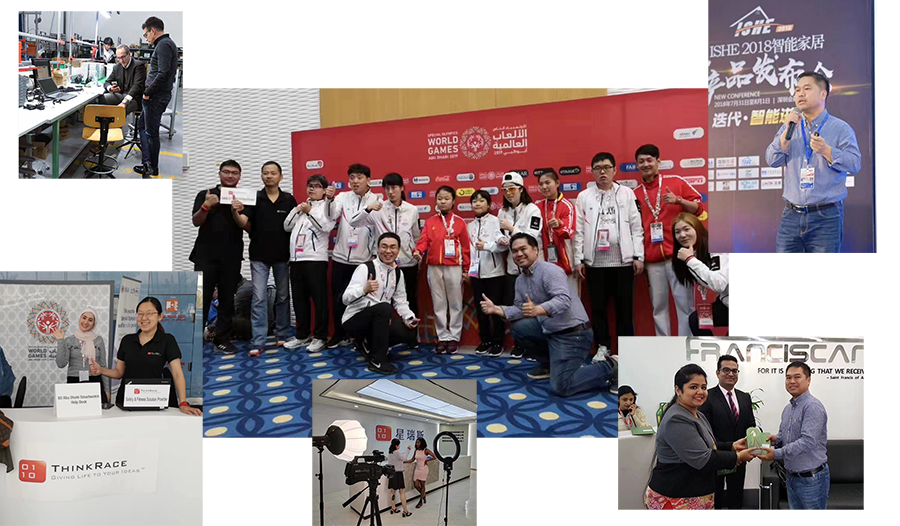
About ThinkRace
ThinkRace is a smartwatch manufacturing factory, and although we are not a traditional software company, we have participated in hundreds of large-scale projects after more than 10 years of hard work and perseverance, including important events such as Special Olympics World Games. We have partners around the world, working closely with more than 20 telecom operators, and our products and software are used in more than 50 countries, including ministries of health and justice.
In this process, we have always believed that it is our mission and responsibility to protect the safety and health of workers. Our products and software help manage hundreds of jobsites, ensuring that every worker’s safety is taken care of and guaranteed. It’s not just our business, it’s our commitment to society. In the face of challenges, we never forget our original intention and strive to improve the quality of our work, because we know that it is about everyone’s life and health.
While we may not be the best software company in the industry, and we may not be perfect in terms of documentation and design, we firmly believe that it is this dedication to mission and commitment to social responsibility that makes us the most dedicated team in this field. We will continue to strive for excellence and work tirelessly to create a safer and healthier future.


